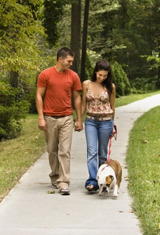WALKING AND YOUR FEET
About 67 million men and women in North America have discovered how walking is one of the most fun, natural, and inexpensive ways of keeping your feet in top shape. The basic kind of walking — often called healthwalking — can be done almost anywhere and at any time, year around.
For those with a long history of inactivity, problems with obesity, or who just don’t like strenuous activity, walking is an excellent way to begin an exercise program.
 Exercise walking has a host of benefits.
Exercise walking has a host of benefits.
Walking helps control weight, blood sugar, and cholesterol levels. A brisk walk can burn up to 100 calories per mile or 300 calories per hour.
Walking also improves cardiovascular fitness. As an aerobic exercise, walking gets the heart beating faster to transport oxygen-rich blood from the lungs to the muscles. The heart and lungs grow more efficient with a regular walking regimen, reducing blood pressure and the resting heart rate. Walking is even a central element of medical rehabilitation.
Recovery from many ailments, including heart attack, is facilitated by a regular walking regimen.
In addition, walking creates an overall feeling of well-being, and can relieve depression, anxiety, and stress by producing endorphins, the body’s natural tranquilizer. A brisk walk will relax you and also stimulate your thinking.
If you are more than 40 years old and have any problems with weight, respiration, blood pressure, pulse rate, or cholesterol, check with your doctor before beginning a walking regimen. The same goes for diabetics, smokers, or people with preexisting injuries or a family history of heart problems.
Don’t neglect your feet when embarking on a walking regimen. Wear thick, absorbent socks (acrylic is preferable to cotton); dry feet well after bathing, paying special attention to the toes, and use powder before putting on shoes. Nails should be cut regularly, straight across the toe.
Avoid self-treatment of corns and calluses with over-the-counter remedies before starting to walk. And if you have bunions or hammertoes, consult first with blisters develop, self-treatment by opening them with a sterilized needle and draining the fluid. Cover the treated blister with antibiotic ointment to prevent infection.
